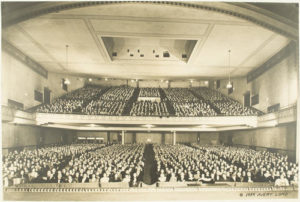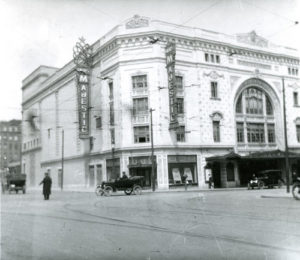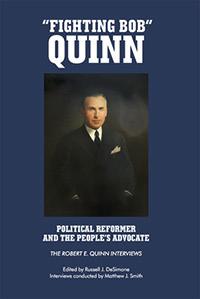Pleasure the means, the end virtue.[1]
Once upon a time, and in living memory, at least for some of us, there were a number of movie houses in the downtown Providence area; and most Providence neighborhoods had a movie theater as well. I was one of the lucky ones. Not only did I have a neighborhood theater, the Uptown, I also lived close enough to downtown to be able to walk to the city’s theaters. It was a magical time to be a kid. Now there are no movie houses in the city other than in the enclosed Providence Place Mall. At least some of these old downtown theaters still stand and are being put to good use. Today we have megaplexes situated in the suburbs or at malls. They have many screens in which to view a movie – some with 10, 12 or even 14 screens. At such entertainment emporiums you can spend $20 or more for soft drinks and a bucket of popcorn. In some, you can even order a pizza or buy hot dog, get a beer or glass of wine, and sit in seats that recline while you enjoy a movie in surround-sound. Even with all these new features, going to the movies today doesn’t seem to generate the same kind of excitement as it did years ago. Back then, before television became popular and way before computer screens, going to the movies was special: it was the highlight of the week, and people even dressed-up for an evening show. Now it seems going to the movies is just another thing to do.
As a young boy growing up in Providence in the 1950s, I was occasionally allowed to go to my neighborhood theater, the Uptown Theater on Broadway, during lazy summer Saturday afternoons. Accompanied by my two cousins, also young boys, we would get to see a double feature interspersed with a newsreel, cartoons and at least one serial movie, usually about cowboys. It was a wonderful time for any kid who had the price of admission – 25 cents. Looking back on it from my parents’ perspective, for a small amount of money they got some quiet time – it was cheaper than a babysitter. The shows were noisy affairs with a bunch of pre-pubescent kids running about creating disturbances. My cousins were often some of the first to be ejected for rowdy behavior. The rule of law was enforced by Jack the Usher, a retired Providence fireman. It was under such circumstances that I, as with many other kids, got my first exposure to the theaters of Providence.
As I got a bit older, I was allowed to go into downtown Providence to see a movie with my friends. I distinctly remember seeing the movie Apache starting Burt Lancaster. I thought it was the greatest movie ever made—the year was 1954. I was forever smitten with the movies and my theater going options were now open to all the downtown movie houses, including the Majestic, Strand, R.K.O. Albee and Lowe’s State, as well as the Capitol in Cathedral Square.
Modern Theaters
The downtown Providence area might best be described as encompassing all streets from South Main to Empire streets and from Sabin to Pine streets. As a young boy exploring the delights of the city in the mid-to-late 1950s the four main movie theaters were the Majestic and Strand, both on Washington Street, the R.K.O. Albee on Westminster Street, and Loew’s State on Weybosset Street.
By this time vaudeville was dead and cinema was king. There were some theaters with live acts that lasted into the 1950s. Fay’s Theater, formerly the Union Theater, lasted until the early 1950s, offering a live show followed by a movie. The Metropolitan at Broad and Chestnut streets lasted until 1955.
Ironically, some theaters were actually nothing more than converted churches. This amounted to an amusing turn-around since churches were at-first decidedly against theaters. The earliest example of this was the Pine Street Theater that was the former meeting house of the Second Baptist Society. Twentieth century examples of church-to-theater conversions include Bullock’s Theater, which once had been the Richmond Street Baptist Church, and the Scenic Temple (later named Rialto) on Mathewson Street, which had been the Westminster Congregational Church. (Both of these theaters for a time showed both vaudeville acts and movies).
My first entry into the world of downtown theaters started with the Majestic on the corner of Empire and Washington streets. I pleaded with my mother to allow me to go as it was just a short 10-minute walk from my home on Carpenter Street. She was very reluctant to approve of this, but as I was allowed to go to the public library on the opposite corner of the Majestic at Empire street, coupled with my unrelenting asking, she finally capitulated. From that time on I was a denizen of the city. Not only did I frequent movie theaters, I also explored the treasures of the downtown. My favorites included the City Hall Hardware Store, the Outlet Company, Shepard’s and the Boston Store. I loved looking in the windows of the Joke Shop on Union Street, and the haberdasher windows of Honorbuilt, as well as strolling by or into the Paramount and the Prep Shop on Mathewson Street. Sometimes I stopped into Liggetts for a Lime Rickey. (For the uninitiated, Liggets was a drug store at the corner of Mathewson and Weybosset streets, and a lime rickey was a soda fountain drink (non-alcoholic, of course)). It was a great time to be a kid.
The Majestic, at 201 Washington Street, was built in 1917 (William R. Waller and Son, architects) and offered vaudeville acts as well as movies. On occasion a “highbrow” showing would take center stage as it did on Monday evening, March 7, 1921, when Anna Pavlowa’s Ballet Russe was shown. George M. Cohan appeared here several times before the stage was reconfigured in 1923 to accommodate movies. The building’s magnificent multi-color pastel terracotta front and the beautiful stained-glass oval dome make this building a treasure. First named Emery’s Majestic, it was later renamed Shubert’s Majestic before it became simply the Majestic. Now it is home to Trinity Repertory Company and has been redesigned to hold two theaters: the Dowling and the Chace theaters. The theater has also been renamed the Lederer, in recognition of the substantial donation made by the Lederer Foundation to purchase the building. My first movie at the Majestic was the 1954 horror classic The Creature from the Black Lagoon and while I have been going there (the Lederer) for many years as a Trinity Rep season ticket holder, it will always be the Majestic to me. Descending the long flight of stairs to get to the men’s rest room, well below street level, I have come to realize some things haven’t changed at all, even if it has been sixty-seven years since I first used those stairs for just such a purpose.
The Strand, at 84 Washington Street (Thomas J. Hill Pierce, architect), is two years older than the Majestic. Of the “big four” “downcity” theaters of my youth, it was my least favorite. Less ornate than the Majestic or for that matter the Albee or Lowe’s, it was just uninspiring. The one thing that stands out in my mind was the great enjoyment I got in seeing Bell, Book and Candle in 1958. Just a teenager at the time I was impressed with the beautiful and talented actress Kim Novak – what boy wouldn’t be? I also enjoyed the other actors too, especially Jack Lemmon. A year later the Strand offered Some Like It Hot, a classic with Marilyn Monroe, Tony Curtis and Jack Lemmon. The Strand still lives on today as a venue for live music performances that attracts a young audience. For a time, it was Lupo’s Heartbreak Hotel.
The R.K.O. Albee was located at 320 Westminster Street (A. E. Westover, architect), a street that has been home to some of the most significant theaters in the city, including the Bijou, Keith’s, Nickel, Empire and Imperial, as well as pre-movie theaters like Academy of Music, the Providence Theater and Music Hall.
The Albee, as it was commonly referred to, was built in 1919 for Edward F. Albee’s stock company and the theater’s first name was the E.F. Albee. Interestingly, this theater’s entrance and lobby sits on the same lot of land that housed the Nickel Theater. The theater itself was off to the right of the hall of mirrors lobby. The building was elaborately decorated in marble and had two balconies. Not only did it provide a suitable home for the Albee stock company, it was also used for cultural performances such as the Boston Symphony Orchestra. By my time, the stock company was no more, and it was primarily a movie house. In fact, my first memory of going to a movie was at the Albee and I still distinctly remember walking out of the theater after seeing a Disney movie with my parents holding my hands. It would have been either the late 1940s or very early 1950s.
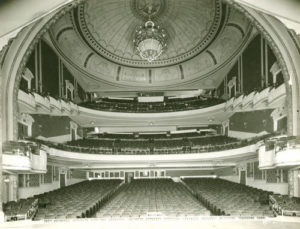
View from the stage of the interior seating and architecture of the Albee Theater. The theater has two balconies above the seating on the mezzanine, and also has many boxes along both sides of the wall. A large chandelier in the center of an ornate dome hangs in the center of the room (Providence Public Library Digital Collections)
Sometime in the 1960s the theater was acquired by entrepreneur B.A. Dario, a car dealer and racetrack owner. For a while, the theater was used for musical events, but it never was a profitable concern. Dario’s ownership was just a stay of execution—the theater finally fell to the wrecking ball in 1970. Today the theater’s location is just another parking lot in Providence.
The Loew’s State, located at 220 Weybosset Street (Rapp and Rapp, architects), was built in 1930 as a picture palace. Anyone who visits its successor today, the Providence Performing Arts Center (PPAC) will readily agree it is a palace. Ornately decorated and meticulously restored it still has the feel and grandeur as it had when it first opened. While I have been to numerous PPAC shows, I still remember the first time I went to Loew’s to see the movie Apache starring Burt Lancaster. I thought then it was the best movie ever made (my taste in movies has, I hope, improved somewhat since then). My most memorable experience at this theater was not watching a movie but experiencing the thrills of the the candy dispensing machine on the mezzanine. For whatever reason, when I put a coin in the slot and pulled the lever for a box of Mason Dots (my favorite at the time), instead of one box I got two.
Providence had many other modern theaters that are not covered here, but each added to the options the theater-going public had. Among these were the Emery, later renamed the Carlton, on Mathewson Street, Fay’s on Union Street, the Metropolitan on Chestnut Street, and the Modern on Westminster Street. A late comer to the downtown theater scene was the Paris Cinerama on Weybosset Street, which opened in 1969 and closed in the 1980s.
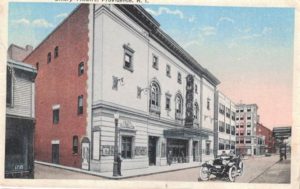
The Emery theater, later renamed the Carlton, was located on Mathewson Street. Today its location is a parking lot (Author’s collection)
Neighborhood Theaters
With the advent of the silent movies in the early 1920s a number of neighborhood movie houses began to appear. Nearly every neighborhood had one, although some were grander than others. Over time these theaters served as second-run theaters where patrons could see a movie for less money than the first run theaters of downtown. Listed here are some in alphabetical order with accompanying information on each.
Art – This theater began life as the Liberty Theater and opened in March of 1921. It was renamed the Art in 1958 and was known for its artistic movies. Located at 1017 Broad Street it served the Elmwood and Washington Park areas of Providence although many of its movie selections attracted audiences from all over. The theater has long been closed but recently it was renovated to be used as an entertainment center and was renamed the Bomes Theater.
Auburn – This theater lasted only four years after a fire in 1918 ended its run. Located in Cranston on Park Avenue near the corner of Elmwood Avenue it was close enough to the Providence city line to serve residents of the Elmwood area. This building is still standing.
Avon – This theater, located at 260 Thayer Street on Providence’s East Side, has the distinction of being one of the few remaining neighborhood theaters still in operation. It opened in 1938 and today remains a vibrant member of the Thayer Street business district. For decades it has attracted not only students from nearby colleges, particularly Brown University and Rhode Island School of Design, but patrons throughout the state interested in the artistic movies shown there.
Cable Car – Although recently closed, the Cable Car can be considered a downtown theater as it was located on South Main Street. A late comer to the theater scene, it opened in 1976, and like the nearby Avon Theater, it showed mostly artistic movies. The Cable Car had an unusual seating arrangement as most of the seats were old sofas. Today the theater is used as a café and for animated shorts and other microcinema.
Capitol – The Capitol was located on Westminster Street in Cathedral Square. While listed here as a neighborhood theater it could just as easily be considered a downtown theater since it was only a few minutes’ walk from the city’s center. It is also older than most of the neighborhood theaters as it opened its doors in 1902 and initially featured vaudeville acts before becoming a movie house. It also had the distinction of hosting the most impressive inaugural act of any neighborhood theater. Opening night on September 22, 1902, featured the Four Cohans in “The Governor’s Son” with Providence-born George M. Cohan as the youngest Cohan. The theater has undergone a number of name changes. It began as the Imperial, before becoming the Shubert, then the Colonial, and finally the Capitol. When I went there in the 1950s it was a run-down reminder of its glory days; we called it a “scratch house.” The theater was torn down in the mid-1960s as part of redevelopment in the area.
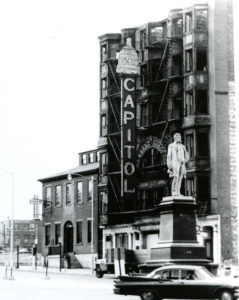
The Capitol, which one time featured George M. Cohan (Providence Public Library Digital Collections)
Castle – The Castle Theater, located at 1025 Chalkstone Avenue, opened in the 1920s to serve the Mount Pleasant neighborhood of Providence. It lasted as a movie house until early into the 21st century. Today the theater houses a pizzeria.
Cinerama – This theater was located on Hope Street and was initially and aptly named Hope Theater. Built prior to 1928 it lasted as a theater until the 1980s. During the 1960s it was one of the few neighborhood theaters where patrons could see a movie in CinemaScope (which used special equipment to project an image that was almost two-and-a-half times as wide as it was high). The theater was eventually demolished and is now the site of a national drugstore chain.
Columbia – This theater was located at 589 Charles Street and initially was named the Continental. Its name changed one last time from the Columbia to the Rivoli before the building was eventually razed. It served the city’s North End community comprised largely of Italo-Americans.
Elmwood – The Elmwood is a more recent theater than the other neighborhood theaters. It was built in the 1940s and closed sometime in the 1980s. The building, located at 786 Elmwood Avenue, was for a while repurposed as a church serving the local Hispanic community.
Olympia – This theater was located on Westminster Street in the Olneyville section of the city. It opened to the public in September 1926. Developed by Jacob Conn it was often referred to as Conn’s Olympia. The theater was ultimately razed and replaced by a high-rise low-income apartment building.
Palace – The Palace, like the Auburn Theater, was located in Cranston. But it was near enough to the city line to serve residents of Providence’s Washington Park community. Located at 1526 Broad Street this theater finally closed its doors in the 1970s and the building has since been repurposed as a church.
Rainbo – This theater was located on Pocasset Avenue in the Silver Lake neighborhood near the Cranston-Providence line; it is now gone, and a bus turn-a-round is in its place. Initially named the V.C., its name changed to the Rainbo in the early 1940s. The theater closed in the early 1950s. Why there was no ‘w’ in its name is anybody’s guess.
Royal – The Royal was located at the junction of Plainfield Street and Manton Avenue in Olneyville. The theater opened on October 27, 1914 as a movie house. It closed in 1934, possibly due to competition from the Olympia at the opposite end of the square. After years of being boarded up it was razed sometime around the late 1950s or early 1960s to make way for a gas station.
Star – There were two Star theaters. One was located in South Providence on Willard Avenue and the other was in Cranston on the line between Providence and Cranston. The latter was a neighborhood theater for residents of both Providence’s Silver Lake area as well as Cranston.
Uptown – Located on Broadway this theater was initially named the Columbus. It was renamed the Uptown in 1929, but in 1962 it reverted to its original name. Without doubt it was the most elaborate of all the neighborhood theaters in Providence. Opened in 1926, the Uptown’s impressive design by architect Oresto DiSala and murals by George DiFelice made this theater a standout. Today the theater survives by offering live musical, theatrical and screen programs.
While not within the memory of most modern-day readers, Providence had other neighborhood theaters in the early decades of the 20th century that are, sadly, long gone. They include movie theaters such as the Pastime in Olneyville and the Palace Casino in Randall Square. Other early theaters catered to the city’s immigrant communities; among these were the Verdi and Teatro La Sirena, both located on Atwells Avenue in the heart of the Italian enclave. Bazar Hall, later renamed the Star Theater, located on Willard Avenue in South Providence, catered to a large Jewish community and played movies on Friday nights – the cost of admission was ten cents.[2]
In addition to the array of neighborhood theaters, several drive-in theaters appeared. Most notable among them was the Shipyard Drive-In that first opened in 1957 and ran for nearly twenty years at Field’s Point off Allen’s Avenue. This drive-in got its name from the Walsh-Kaiser shipyard that built Liberty ships and patrol frigates at this location during World War II.
Conclusion
Theater going has certainly changed over the years. Except for the old Loew’s State (now the Providence Performing Art Center) and the Majestic (now Trinity Rep’s Lederer) the grand movie houses of the downtown Providence area are gone forever. Gone too are most of the neighborhood theaters, with the exceptions of the Columbus and the Avon. Still, making the occasional trip to see a live performance at PPAC, Trinity Rep. or the Columbus, or a movie at the Avon, will give the theater goer a glimpse into Providence’s theater-going past. This is a thrill that no mall-based megaplexm theater can ever give.
References
Of invaluable use in telling the story of Providence’s theaters is the on-line resource Cinema Treasures at http://cinematreasures.org/. Much of what is provided on this site was provided by Gerald DeLuca, Rhode Island’s foremost living scholar on the history of the theater in Rhode Island.
Notes
[1] The motto on a banner that hung over the proscenium of the Providence Theater on Westminster Street, the city’s first theater in 1794. [2] See George Goodwin and Ellen Smith, The Jews of Rhode Island (Waltham, MA: Brandeis University Press, 2004), p. 46.


